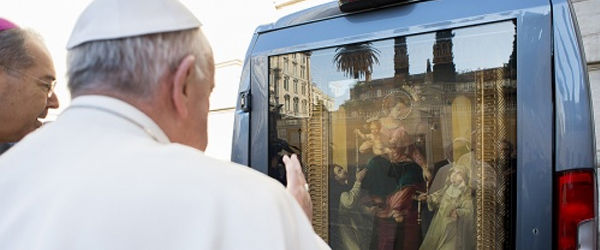Holy Cross combines with community to grow food that will help feed those in need.
A once barren, clay-soil corner lot on the property of Holy Cross Church in Santa Barbara, home to a few gophers and several local varieties of weeds, is slowly being transformed into a “food forest” that will eventually provide fruits and vegetables to local needy families.
In October, the Mesa Harmony Garden celebrated one year in existence and is now home to 270 food-bearing trees in addition to various berries, vegetables and shrubs.
“The garden has progressed amazingly well in its first year,” says Deacon Randy Saake of Holy Cross Church. “Cardboard sheeting and several inches of mulch has brought life back into the soil and helps keeps the weeds down.”
The Mesa Harmony Garden originated from a class paper by a small group of Santa Barbara City College students. Their project was to hypothetically plan a community garden that would be the collaborative work of local service groups and community members with the goal of providing food for the needy. The students brought the idea to the Holy Cross parish council as part of their assignment.
Realizing that the plan would be a good use of the land, the parish set out to make it a reality.
“Before anything was planted, we did our research,” Saake points out. A plan was drawn up by Larry Saltzman, a local permaculturist, who also researched what would grow in the local climate and be easily sustainable.
“For example, several types of apples and peaches will do well here,” Saake explains, “and we also received recently some California Mission grapes from Santa Ynez.”
The permaculture concept of producing “food forests” relies on combining food producing trees, shrubs, plants and vines with beneficial flowering plants, ground covers and root vegetables in such a way that a minimum amount of the earth’s resources are needed to maintain the production of food. The plantings also attract beneficial insects to the garden. Eventually, as the plantings grow and mature, the garden will have a “canopy” look with multiple levels of food-producing trees and plants.
The garden is a now a work-in-progress involving local community members, Holy Cross parishioners, the Santa Barbara Food Bank, and members of the local Permaculture Community. Community volunteers and donors have dedicated hundreds of hours and resources just to prepare the soil, plant and maintain the garden in these early stages.
Saake says the project has united many facets of the community, an area known as the Mesa. “There is strong community energy around this project,” he observes. “People are really eager to participate, and they are from many faiths and backgrounds.”
The project has been somewhat of a financial burden on the parish in these early stages due to the large amounts of water needed to get the garden going. But Saake says Holy Cross’ pastor, Josephite Father Ludo DeClippel, is “two-hundred percent behind this project” and sees the positive side of growing this garden to produce food for those in need.
Hoping to have their first harvest of fruit in the spring, the parish and community are also fully backing the project with either monetary contributions, or donations of seeds, plants, equipment and their time.
“And word of mouth,” Deacon Saake adds with a smile. “Everyone out here knows about it.”
{gallery width=100 height=100}gallery/2011/1209/sbgarden/{/gallery}

